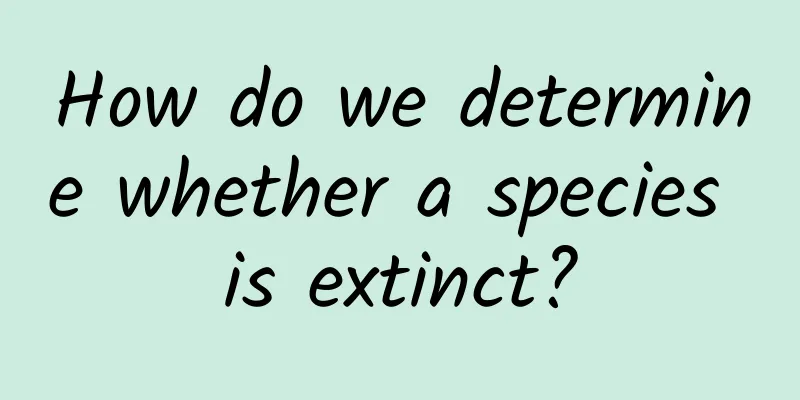How do we determine whether a species is extinct?

|
If you make a wrong judgment, the life that will be harmed is the very life you are trying so hard to protect. By Andy Carstens Translation | Wang Chao On a cloudy morning in 2021, self-taught ornithologist Mark A. Michaels was marking a sweetgum tree in the forests of Louisiana, USA. At this time, he spotted a bird flying under the canopy 50 yards away. Based on its size and neck length, Michaels deduced that it was a duck. However, he also noticed that the bird would intermittently fold its wings in flight - "ivory beak"! Michaels was extremely surprised. Ducks don't fly like this. He determined that the bird was the ivory-billed woodpecker (Campephilus principalis) he had been looking for for 15 years. There has been no definitive field identification of this bird since 1944. Figure 1: An ivory-billed woodpecker photographed in 1932 by Arthur A. Allen and the Macaulay library at the Cornell lab of ornithology As an assistant researcher at the American Ornithological Society, Michaels had suspected that he had seen the ivory-billed woodpecker many times, and several times he had seen it in the tree just now, but he had never been able to convince himself that it was real. But this time was different, "That was the first time I was absolutely sure that I really saw it." Michaels is convinced that there are still ivory-billed woodpeckers in the wild, but others are less sure. In September 2021, the US Fish and Wildlife Service (USFWS) proposed a ruling declaring the ivory-billed woodpecker—along with 22 other species—extinct. If the ruling goes into effect, it would remove the ivory-billed woodpecker from the federal endangered species list and formally eliminate protections required by the US Endangered Species Act, such as no longer having to protect the bird's habitat or trying to increase its population size. However, the data behind this proposal is controversial. At a hearing held in January 2022, USFWS received conflicting evidence that scientists had serious disagreements about the status of this woodpecker, which deserved further review. Therefore, USFWS issued a stay notice on July 6: another six months, and then decide whether to remove the ivory-billed woodpecker from the existing endangered species protection list after six months. Researchers face many difficulties in determining whether a species is truly extinct, and the ivory-billed woodpecker is an example. "It is very difficult to prove that something does not exist," said H. Resit Akcakaya, an ecologist at Stony Brook University. And "not seeing" does not prove extinction. The International Union for Conservation of Nature (IUCN) is an organization that tracks the conservation status of species based on surveys, modeling and expert advice. According to IUCN guidelines, "when there is no reasonable reason to suspect that the last individual has died, the taxon is considered extinct." But usually, researchers do not know when the last individual died, or even whether the last individual has died. More importantly, Akcakaya believes that there is a cost to misjudging a species' extinction. If a species is already extinct but is still considered endangered, it will lead people to underestimate the rate of species extinction, blur the larger picture of nature conservation, and divert money that could have been used to protect vulnerable species to search for species that do not exist. Conversely, if a species is declared extinct when it is not, these struggling species may be further harmed. The cost of premature extinction declarations The Cebu flowerpecker (Dicaeum quadricolor) is a small, colorful songbird native to the Philippines’ Cebu Island. It was presumed to have gone extinct around 1906, when ornithologists in the early and mid-20th century failed to find any traces of it, and a 1998 article by conservation biologist Nigel Collar and BirdLife International speculated that deforestation had left the bird with insufficient habitat to survive. This conclusion failed to inspire conservation efforts on Cebu Island, and logging continued to ravage the remaining forests. It was not until the 1990s, when the Cebu flowerpecker was rediscovered, that only small patches of forest remained on Cebu Island, scattered across the island and covering less than one-third of its original area. Although the Cebu Flowerpecker still exists today, its future is not optimistic: according to the species assessment released in 2021 by the IUCN Red List of Threatened Species, the population of the Cebu Flowerpecker is approximately 60 to 70, and this number is still decreasing. Falsely declaring a species extinct can sometimes be like casting a spell that can lead to the species actually going extinct. As Akcakaya said, "Our biggest fear is that we think a species is extinct, so we stop protecting it, and then it actually goes extinct because of the lack of protection." This situation is called the "Romeo Error" because in the finale of "Romeo and Juliet", Romeo thinks Juliet is dead, so he commits suicide, and then Juliet commits suicide because of this. "It's a self-fulfilling prophecy." If the USFWS decides to declare the ivory-billed woodpecker extinct, will it make a Romeo mistake? “It’s possible,” Michaels says, but he’s optimistic it won’t happen, largely because the service’s approach to the bird, which it has been considering extinct for decades, doesn’t seem to have had any adverse effects. For each endangered species, the USFWS has a species recovery plan. Under the ivory-billed woodpecker recovery plan, conservation efforts focus on finding the bird and protecting habitat only after a population is found. Although there’s no formal requirement to protect the ivory-billed woodpecker’s forest habitat, good existing management practices already do that, Michaels says. Michaels hopes that management practices will continue even if the ivory-billed woodpecker is declared extinct. But he knows that once an extinction declaration is made, there will be less incentive to maintain existing management practices, which could hurt species that share the same habitat as the bird. If a species is rediscovered after being declared extinct, it can raise more questions. Akçakaya says the discovery of a “Lazarus species” could undermine public trust in scientists and, in some cases, stimulate the poaching market. Michaels says that while the elusive ivory-billed woodpecker won’t have to worry about poachers for a while, if the bird is discovered, demand for its collection could surge. Additionally, Michaels points out that if too many well-meaning people want to help find the ivory-billed woodpecker, it could damage its habitat. In the past, attempts to prove that the woodpecker is not extinct have resulted in casualties: In the 1930s, hunting and logging caused a significant decline in the ivory-billed woodpecker population, and people began to wonder if the woodpecker had been killed and extinct. To allay public suspicion, Louisiana Congressman Mason Spencer shot an ivory-billed woodpecker and used its carcass as evidence. For all of these reasons, Michaels says they will no longer reveal the specific locations where they are searching for the ivory-billed woodpecker. Keep it secret to avoid extinction So-called Lazarus species are creatures that were thought to be extinct but have since been found in the wild. Ecologists and others who encounter Lazarus species often face a dilemma. On the one hand, sharing news of a “rediscovery” can galvanize public support for protecting the creature; on the other hand, such news can also incite poachers. Vincent Nijman, a wildlife trade expert at Oxford Brookes University in the United Kingdom, says that animals can end up in an extinction vortex: Every time an animal is killed, the value of the remaining ones rises. Growing demand can drive poachers to exterminate a species for profit, as happened to the native Javan rhino (Rhinoceros sondaicus) in Vietnam in 2010 (Biol Conserv, 174:21-29, 2014). A few years later, the Sumatran rhino (Dicerorhinus sumatrensis) suffered the same fate. The Sumatran rhino, which had been missing for a while, was rediscovered in Kalimantan, Borneo, in 2013. Historically, the rhino had been abundant in Southeast Asia until the early 20th century, when poaching for its valuable horn nearly wiped it out in the 1970s (Biol Conserv, 175:21-24, 2014). At the time, Nijman said, although many people believed the rhino was extinct, poachers didn’t think so. They believed that the rhino could still be found in some remote areas, but the months-long expedition was not worth it. That changed when the Sumatran rhino reappeared in 2013 and made global headlines. “As soon as the rhino hunters in Sumatra heard the news, they set off to Kalimantan.” In Nijman's opinion, the wiser approach would have been to keep the new discovery secret. That way, more resources could be invested in animal conservation to help the species recover. But once the news was announced, a huge amount of money had to be invested overnight to protect the Sumatran rhino from poachers, and rainforests cannot be fenced off and managed, which is not easy to deal with poachers. Nijman said that delaying such announcements for even a few years could buy some very critical recovery time for the Lazarus species. Figure 2: Because the horns of white rhinos are embedded in their faces, poachers kill them and remove the entire skull to trade on the black market. Modern methods: estimating species extinction probability Akcakaya, who now volunteers as chair of the IUCN's Standards and Petitions Committee, said that to help scientists determine whether a species is extinct, the IUCN has developed a method that allows scientists to make more use of existing data. The method, published in 2017 and incorporated into IUCN guidelines in 2019, combines two approaches to assessing the likelihood of extinction to infer the status of species (Biol Conserv, 214:336–42). The first approach uses "exhaustive surveys," which survey all known or possible habitats where a species has historically appeared during the seasons and times when they should appear. The more surveys are conducted and the wider the area searched, the more reliable the assessment. The second approach estimates the probability of extinction based on the range and severity of the threats facing the species. For example, the more the habitat of a missing species has been reduced, the more likely it is that the species has become extinct. While government agencies like the USFWS make their own decisions based on specific laws and regulations, the methodology can provide some guidance on whether to continue investing in protecting a species. Stuart Butchart, an ornithologist at BirdLife International, was one of the first scientists to test the method. He believes that the method is valuable because it "forces users to explicitly consider information from different sources" and "helps to improve the consistency of assessments." In 2018, Butchart and his collaborators used the method to assess dozens of bird species (Biol Conserv, 227: 9-18). When the probability of extinction assessed by both pathways exceeded 50%, they recommended that the species be considered "critically endangered" and "probably extinct." Only when both assessments resulted in a probability of extinction greater than 90% would they recommend that the species be classified as "extinct." For the ivory-billed woodpecker, Butchart estimated a 75% probability of extinction using the second approach—based on threats to the animal—due primarily to habitat loss, while the probability of extinction based on surveys and recorded sightings was lower, at about 20%. The latter approach takes into account the possibility of misidentification in records, but if multiple records contain the same misidentification, it may underestimate the probability of extinction. Based on these results, Butchart and his colleagues recommend that the ivory-billed woodpecker be classified as critically endangered, although that assessment could change given new evidence collected recently by Michaels and others. Final verdict: whether a species still exists While data-driven approaches are certainly helpful, they’re not always enough to reach definitive conclusions. In some cases, there’s simply not enough information about a species to make reliable predictions, says Kelsey Neam, a conservationist at the nonprofit Re:wild. She has tested the IUCN approach with amphibians but hasn’t used it to infer the status of a species, in part because of a lack of information. “It would be nice to have a lot of data on amphibians, but we don’t have that.” Whether there is much or little data available, the final conclusion will come from a panel of experts. As assessment coordinator for the IUCN Amphibian Specialist Group, Neam leads a working group of experts from a particular region to review the status of a species, which is like a jury's job. "Sometimes there is unanimity and everyone says, 'Yes, it's completely extinct.' But other times there is a lot of debate." Local experts who love a species sometimes hesitate to declare it gone forever, Neam said. They may hesitate because they are afraid of making a Romeo mistake, because the species is taxonomically important, or because it just "looks cool." As an expert using the IUCN criteria, Neam's job is to remain neutral and unbiased. "I often feel like I'm the chief jury, and it's very stressful," she said. She also said that one of the most important factors in the review process is determining whether the survey is exhaustive, but she acknowledged that "it's a qualitative exercise." Sitting down with investigators can help assess the scope of the survey. When people hesitate or mention that a species may be found in another area, "that's when alarm bells go off in my head," she said. "You know, it's not wise to declare a species extinct at that moment." Discussions like these usually result in deciding where to search next. Neam said that when everyone agrees that a species no longer exists, the air suddenly becomes quiet. "You get goose bumps. Because it's not like you pronounce one sentence and then move on to the next one. At that moment, we sit there and really mourn the loss of those species." Michaels hopes the ivory-billed woodpecker won't make it that far. But he's worried about something else: that people are demanding too much evidence, and that he might not be able to provide clear photos to prove the bird is still alive. He told the USFWS that many of the bird photos taken in the 1930s put an unrealistic burden of proof because most of them were taken from the seclusion of nest heights, close to the birds, and "staged." In contrast, his evidence is all blurry images and video clips extracted and enhanced from drone footage. "It's a very, very difficult thing to do," Michaels said, "because you're shooting up into the sky, it's all backlit, and the bird is flying very fast." In a frame-by-frame demonstration, he pointed out the ivory-billed woodpecker's distinctive features, such as its white secondary wing feathers, its long neck, and the stripes on its back that run from its shoulders to its face. "It would be nice to have a photo that showed its big white beak clearly," but his photo didn't have one. Now, he can only wait for the USFWS to make a ruling. "I don't know what the result will be, and I won't guess." Michaels said that the previous extension order issued by the administration was a placebo, indicating that the government is seriously considering the possibility that the ivory-billed woodpecker still exists. But he himself has no doubt in his mind: "I am 100% sure it is there." Figure 4: Mark Michaels (left) and Steve Latta of the American Birding Society examine woodpecker foraging tracks on a tree. This article is translated with permission from https://www.the-scientist.com/careers/how-do-scientists-decide-a-species-has-gone-extinct-70972 Produced by: Science Popularization China |
<<: The neglected soil is inextricably linked to our human health | Chen Nengchang
>>: Shangsi Festival丨Come on~Come to the Dong Village to sing and party!
Recommend
Why did soy sauce become light soy sauce or dark soy sauce? What is the relationship between them?
A dozen or twenty years ago, it was rare to see t...
Baidu announces the opening of its autonomous driving platform
Baidu has launched a new program called "Apo...
Fatigue, memory loss... Is it because your brain is not working enough? Huaxi doctors: Be careful after this age!
I wonder if you have ever missed the past? Recent...
The world's longest-lived crocodile has tens of thousands of offspring! | Natural Trumpet
Welcome to the 72nd issue of the Nature Trumpet c...
Should the Wenchang Tower be made of copper, crystal, or jade?
It depends on the person who needs it and what el...
I have no regrets about joining China! Today, listen to the voices of Chinese scientists joining the Party
"I volunteer to join the Communist Party of ...
How to apply the 80/20 rule in designing self-propagation and new sharing activities?
If you want to enhance the self-propagation abili...
Analysis of 7 bidding methods for Baidu search OCPC
Baidu search ocpc bidding is the current mainstre...
How to launch an offline event at zero cost?
Whether you are a self-media author, koc or kol. ...
User operation examples, creating a lost user recall system
The author will share with you his exploration an...
Attention! What happens if the itinerary code has an "asterisk"? Does it affect your travel? Read this article to learn more
Recently some friends discovered Your own travel ...
Xiamen SEO Training: What is the trend of SEO optimization? What is the premise for stable ranking?
When doing SEO optimization, you need to constant...
Remote control of PC is not a dream, Intel launches remote control application
Technology is meant to make people's lives mo...
Cry first! Staying up late not only hurts your body, but also makes you stupid, ugly and fat
Whenever it’s late at night, there are always som...









